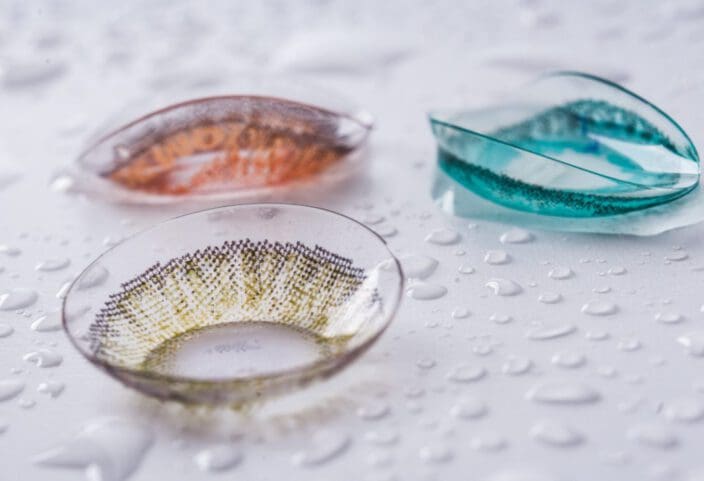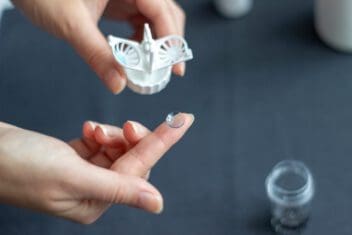Acanthamoeba Keratitis (From Contacts): Symptoms & Treatment
Home / Understanding Contacts /
Last Updated:
Acanthamoeba keratitis is an extremely serious coinfection of acanthamoeba, a common organism found in tap water, and bacterial keratitis. This dangerous condition is closely linked to improper handling of soft contact lenses.
Table of Contents
According to the Centers for Disease Control and Prevention (CDC), 40 to 90 percent of contact lens wearers do not follow care instructions for their contacts. Poor hygiene can result in serious infections that could result in vision loss.
Acanthamoeba keratitis is rare. Because cases of it aren’t required to be reported to state or federal health organizations, the CDC is unsure how many people experience the infection each year.
Symptoms of acanthamoeba keratitis include a red and excruciating eye infection that doesn’t improve with treatment, along with light sensitivity, blurred vision, and long-lasting pain after taking out contact lenses.
Avoiding the most high-risk contact lens care behaviors, which include using tap water as part of a contact lens care and cleaning regimen, swimming with contacts in, and swapping contacts with someone else, can greatly reduce the risk of contracting acanthamoeba keratitis.
Following contact care lens care instructions and maintaining proper hygiene while handling contact lenses can also help to lower the risk of contracting eye infections.
Aggressive and early treatment — usually with an antibiotic or topical medicine — is required to treat acanthamoeba keratitis before it results in irreversible vision loss or the need for a corneal transplant.

What Is Acanthamoeba Keratitis?
Acanthamoeba is one of the most common organisms in the environment, and it rarely causes infections on its own. When infection does occur, it can be very serious and even result in vision loss.
In recent years, acanthamoeba has gained notoriety for increasing reports of acanthamoeba keratitis, which is a coinfection of acanthamoeba with the bacterial keratitis. Keratitis is an eye condition that causes the cornea (the round dome covering the eye’s pupil and iris) to become swollen and inflamed.
You deserve clear vision. We can help.
With 135+ locations and over 2.5 million procedures performed, our board-certified eye surgeons deliver results you can trust.
Your journey to better vision starts here.
This coinfection most commonly occurs in the contact lens case and on the cornea.
Acanthamoeba keratitis is closely linked with contact lens wear — more specifically, poor contact lens care and hygiene. Before the popularity of soft contact lens use, this coinfection was extremely rare.
How Common Is Acanthamoeba Keratitis?
The CDC reports that keratitis is responsible for 1 million doctor and hospital visits every year. Acanthamoeba keratitis is a very serious form of keratitis and is more rare. Still, research indicates that year after year, the number of cases of acanthamoeba keratitis increases.
In 2007, the CDC began investigating acanthamoeba keratitis cases, after an outbreak of the infection that led to a recall of contact lens solution. While the organization doesn’t have official records of how many cases of the infection are reported each year since cases of the infection are not required to be reported to state health organizations or the CDC, it did open another 2011 investigation into acanthamoeba keratitis after the number of cases didn’t seem to recede to pre-outbreak levels.
Symptoms of Acanthamoeba Keratitis

Acanthamoeba keratitis is an extremely serious and painful infection, with symptoms that may include:
- A red and excruciating eye infection that doesn’t improve with treatment.
- A feeling that something is stuck on or in the eye.
- Excessive tearing.
- Blurred vision.
- Sensitivity to light.
- After removing contacts, an unusually long sensation of pain or irritation, along with redness.
Preventing Acanthamoeba Keratitis: Avoid Risk Factors
Being careful to avoid certain high-risk behaviors can greatly reduce the risk of developing acanthamoeba keratitis. The most high-risk activities are:
- Using tap water in any part of contact lens care or hygiene. Acanthamoeba is very common in tap water. Using tap water in any part of a hygiene regimen, including while washing a contact lens case, can introduce the organism into the environment and onto the contact lens.
- Swimming while wearing contact lenses. Acanthamoeba may be present in swimming water and attach to contact lenses.
- Swapping contact lenses with someone else. This is unsanitary for many reasons, and the other person’s lenses may be infected.
- Using saliva to wet contacts. Acanthamoeba may be present in saliva.
- Using homemade saline solution to disinfect or clean contacts. Homemade solutions are unsterilized and may contain acanthamoeba. Saline solution is not a contact lens disinfectant.
You deserve clear vision. We can help.
With 135+ locations and over 2.5 million procedures performed, our board-certified eye surgeons deliver results you can trust.
Your journey to better vision starts here.
Contact Lenses Care Facts

The U.S. Centers for Disease Control and Prevention estimates that one in six Americans, or roughly 45 million people, wears contact lenses. Globally, that number is about 140 million people, and the contact lens business is predicted to grow to $19 billion by 2024.
An ever-present concern among lens manufacturers and distributors is the cleanliness and prevention of contamination of them. Groups of bacteria called biofilms are present on lenses, and they strongly adhere to the lenses even after cleaning.
In addition, contact lens cases are reported as a major cause of infection among contact wearers. Scientists believe bacteria migrate from cases to lenses. Studies have shown that cases can become contaminated within two weeks of use, and the biofilms in cases are shown to be thicker and more resistant than those on lenses.
Here are a few practical contact lens care tips shared by the American Academy of Ophthalmology to help protect your eyes and prevent Acanthamoeba keratitis:
- Adhere to the schedule given by your doctor or contact lens manufacturer about wearing and replacing contact lenses.
- Strictly follow guidelines and directions from the lens producers and lens cleaning solution manufacturers on safe cleaning and storage procedures.
- Thoroughly wash your hands with running water and soap and dry using lint-free material before handling the contact lenses.
- Rinse your contact lens case with sterile lens solution before leaving it to air dry.
- Always use the rub and rinse method to clean your lenses every time you handle them. This applies regardless of the cleaning solution, i.e., even when you’re using a no-rub cleaning solution.
Use Safe Contact Care

Following the care instructions for contact lenses and contact lens solutions will greatly reduce the risk of acanthamoeba keratitis and other eye infections. Follow these guidelines for safe and hygienic contact lens care:
- Always wash and dry hands before handling contact lenses.
- Rub and rinse the surface of the contact lens with contact lens solution.
- Contact lenses should be cleaned and disinfected with an optometrist-approved, sterile multipurpose or disinfectant product. Saline solution (homemade or store-bought), rewetting drops, and eye moisture treatments are not designed to disinfect lenses.
- Never use tap water to store or wash contact lenses or contact lens cases.
- Every time a contact lens case is opened, the solution inside should be discarded.
- Every time contact lenses are placed inside the case, fresh solution should be used.
- Lenses should be replaced according to the schedule outlined by the prescribing optometrist.
- Unless advised to do so by an optometrist, contact lenses should not be slept in.
- Contact lenses should never be slept in after swimming.
- Contact lenses should never be placed in the mouth or come in contact with saliva.
- Optometrists should be seen regularly to evaluate contact lens prescriptions and eye health.
- If any redness, secretions, visual pain, or blurring is experienced, contact an optometrist or seek immediate medical care.
Treatment for Acanthamoeba Keratitis
Antibiotic eye drops are the most common medication used to treat this coinfection, along with a topical cationic antiseptic agent, such as polyhexamethylene biguanide. Treatment may be required for six months to a year, and pain medication may be also necessary.
Aggressive and early treatment is required to treat acanthamoeba keratitis before it results in irreversible vision loss. A corneal transplant may be required if the infection has progressed to advanced stages or is resistant to many forms of medication.
Frequently Asked Questions
How do you get Acanthamoeba keratitis?
While anyone can contract Acanthamoeba keratitis, people who wear contact lenses make up most of the group that get it.
You can contract Acanthamoeba keratitis after being exposed to the organism, commonly found in water sources like tap water, swimming pools, showers and other contaminated water sources. You can also develop the condition by wearing contaminated contact lenses.
How do you know if you have Acanthamoeba keratitis?
You can identify Acanthamoeba keratitis from the associative signs and symptoms. Some of the prevalent symptoms of the infection include eye pain and redness, blurred vision, watery eyes, cloudy cornea, sensitivity to light and whitish rings on the eye’s surface. If you notice any of these symptoms, schedule an exam with your eye doctor immediately.
How long does Acanthamoeba keratitis take to develop?
The incubation time depends on several factors, the two biggest being exposure level and intensity. Other factors in the disease’s incubation period include the availability of nutrients and temperature. Cysts can form from within few days to several weeks upon contraction.
You deserve clear vision. We can help.
With 135+ locations and over 2.5 million procedures performed, our board-certified eye surgeons deliver results you can trust.
Your journey to better vision starts here.
References
- How Could Contact Lens Wearers Be at Risk of Acanthamoeba Infection? A Review. (November 4, 2010). Journal of Optometry.
- Acanthamoeba. American Optometric Association (AOA).
- Healthy Contact Lens Wear and Care. (July 26, 2018). Centers for Disease Control and Prevention (CDC).
- An Update on Acanthamoeba Keratitis: Diagnosis, Pathogenesis, and Treatment. (February 18, 2015) Parasite.
- Parasites – Acanthamoeba – Granulomatous Amebic Encephalitis (GAE); Keratitis. (April 20, 2011) Centers for Disease Control and Prevention (CDC).
- An Eye on Contact Lens Solutions. (May 30, 2007). Time.
- The Danger of Using Tap Water With Contact Lenses. (March 5, 2019). United States Environmental Protection Agency (EPA).
- An Overview of Keratitis. March 10, 2019. Verywell Health.
- Medical Interventions for Acanthamoeba Keratitis. (February 2015). National Center for Biotechnology Information.
- Blindness Due to Acanthamoeba Keratitis. (July 2008). International Journal of Health Sciences.
- Contact Wearers in National Survey Report Risky Eyecare Behaviors. (August 2015). Centers for Disease Control and Prevention.
- Contact Lens Care. (October 2021). American Optometric Association.
- How to Clean Contact Lenses. (December 2019). Omni Ophthalmic Management Consultants.
- Microbial contamination of contact lenses and lens care accessories of soft contact lens wearers (university students) in Hong Kong. (January 2007). Ophthalmic & Physiological Optics.
- Contact lens technology. (June 2019). University of Birmingham.
This content is for informational purposes only. It may have been reviewed by a licensed physician, but is not intended to serve as a substitute for professional medical advice. Always consult your healthcare provider with any health concerns. For more, read our Privacy Policy and Editorial Policy.
